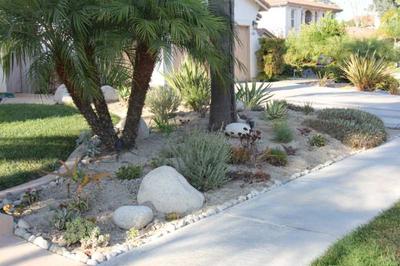
by Peter Gooller
(Chula Vista, California, USA)




I need help with my Succulent Garden. My soil appears to have a lot of clay. I think I may need to add Gypsum…
Hi Peter, generally, clay soil is good for succulents, however, what it needs more than gypsum is most likely gravel. I would mix some smallish gravel, like pea gravel size, into the top part of the soil, which unless it dries into concrete will open it up and prevent the pore spaces from clogging.
You haven’t said if you are growing your plants in raised beds, but this might be a good idea so that the clay doesn’t just get completely waterlogged and rot the roots of your plants.
In some cases the most successful succulent gardens are built with rock walls, which ensures the perfect drainage that these plants need. The soil can be nutrient poor, but absolutely must have the ability to drain.
I’ve also had good success with adding dolomite lime to the soil for succulents, especially in places where it’s had decades of pine needles falling on it, or in your example, the soil is predominantly clay. This helps the plants by adjusting the acidity of the soil into something more close to neutral.
Be aware that Echeveria dislike lime, so if you’re growing those, avoid putting dolomite lime on the garden.
Hope this helps a bit, if you have any more questions, ask me in the comments.
Jacki
Comments for Succulent Garden Soil Issues
Sep 27, 2012
Succulent Garden Soil Issues
by: Anonymous
Jackie, thank you for your response. My soil is very hard starting about 2-3″ below the surface. My garden is in my front yard between a grass area and the side walk, so it isn’t a raised garden. Adding gravel will force me to dig up all the plants in the area. I was also thinking of adding colored wood chips (Mulch) to the exposed areas to give it a more pleasing look from the street, at least until i have enough plants to fill the whole area.
Thank you,
Peter
Hi Peter, please don’t put any kind of wood mulch on the top of the soil for succulents – you will hate it in time, and so will the plants. Use a pebble or lava rock mulch for the best results. You can add this to the soil, scratch it in a bit, and then top it up to give your plants the best chance of success.
Judging from the pictures, plants that I would normally think of as extremely drought tolerant (Aloe species) seem to be the ones that are showing a lot of stress.
Without seeing what the roots look like, I’m thinking that they are not getting enough air around the roots, which is one thing that I’ve found they prefer.
What I would do is get lava rock mulch, and then dig carefully around the plants to remove some of the soil, mix that with a few handfuls of the lava rock and replace it around the plants. This won’t be as much work as removing all the plants, but it will give those plants what they require – good drainage, and more oxygen around the roots.
In some cases, no matter how drought tolerant the plant is, their roots aren’t strong enough to break through hardpan or really tough clay. Their natural habitat would most likely be sandy or gravelly, so very porous.
I can’t tell for sure, but it looks like you have some kind of weeping hose in there – I’m wondering how often you’re watering, and how much per time.
Jacki
Sep 28, 2012
Succulent Garden Soil
by: Peter
Jackie,
Thank you for viewing my photos and commenting. I will try the lava rock mulch around the roots. I removed my drip watering system from that area and at this point I am hand watering the area, about every 3 weeks. The lack of oxygen sounds like a reasonable cause. Is it advisable to place lava rock mulch around all plants as well as in the open areas, so those areas are prepared for future planting?
Thank you again for your expertise.
Peter
I would definitely start putting the mulch everywhere – it will look better for one thing, and as a fan of lava rock, it has many benefits; it holds a bit of moisture under and inside it, as it’s porous; it releases a tiny amount of nutrients every time you water, and it shades the soil, keeping it a degree or two cooler – which might make all the difference.
Looking forward to seeing if it works as well for you as it does for me.
Jacki
You can see more about lava rock here.
Oct 01, 2012
Lava Rock
by: Peter
In San Diego the lava rock available for purchase is approx an inch or large in size. Is this the type of lava rock you recommend I mix in with the soil around my plants to increase the water drainage? Thank you for your expert advice, Peter
Hi Peter, that sounds larger than what I can get around here. The size is probably less than 3/4″, which I’m thinking would work best. If you can’t find some smaller then go ahead and use the bigger kind. It will have the same kind of properties and hopefully the amount of air around the plants roots won’t be an issue.

